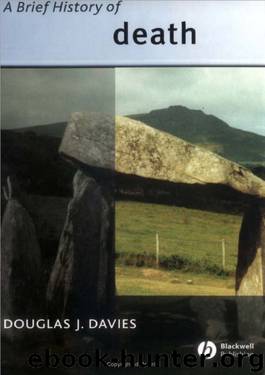A Brief History of Death (Blackwell Brief Histories of Religion) by Douglas J. Davies

Author:Douglas J. Davies [Davies, Douglas J.]
Language: eng
Format: epub
Tags: Gerontology, Death, Social Science, Family & Relationships, Social aspects, Religious aspects, General, Religion, Psychological aspects, Death; Grief; Bereavement, Death in art, Death & Dying, History
ISBN: 9781405101837
Publisher: Blackwell Publishers
Published: 2005-01-15T05:00:00+00:00
the death of any other figure. Every church in every country attests to it, with its meaning being elaborated and developed not only in formal theology and liturgy but also in literature of a more secular kind.
Dante
Amongst such, none in western thought is more elaborate than that of Dante Alighieri (1265–1321). Born in Florence, his spiritual epic-poem Divine Comedy furnishes a distinctive commentary upon life, death and the afterlife. From one perspective it is its own kind of pilgrim’s progress, from another a Christian
‘book of the dead’. Though more a reflection for the living than either a guide for the dying or a manual for priests – as with the Tibetan and Egyptian books of the dead – his three realms of hell, purgatory and paradise offer vivid visions of spiritual possibilities. Divine Comedy was prompted, in part at least, by the death of a close friend, Beatrice, when the 25-year-old Dante was ‘overcome by grief at her loss’ (Musa, M. 1984: 20). In its first volume, ‘The Inferno’, Dante reflects on sin, evil and punishment, providing a vivid verbal account that would be reflected in many later scenes of hellish pain and torment. Some of these depict souls engulfed in flame or having their feet permanently burnt, whilst Judas Iscariot – the disciple who betrayed Jesus – is constantly chewed with his body inside and legs kicking-out from one of the three mouths of Lucifer, the great centre of the underworld who is, himself, half frozen in eternal ice. Other sinners are depicted suffering in a wasteland of burning sand upon which ‘broad flakes of fire showered steadily’, or in a frozen lake of ice with teeth clicking notes as from
‘storks’ beaks snapping shut’. The ordinary symbolism of hot and cold objects is inverted or intensified to dramatize sinners’
experience of them. The scenes encountered by our pilgrim are recounted in sufficient detail to help furnish the medieval mind Art, Literature and Music
93
ABHDC05
93
10/06/2004, 04:44PM
Download
This site does not store any files on its server. We only index and link to content provided by other sites. Please contact the content providers to delete copyright contents if any and email us, we'll remove relevant links or contents immediately.
Aircraft Design of WWII: A Sketchbook by Lockheed Aircraft Corporation(32193)
The Great Music City by Andrea Baker(31254)
Call Me by Your Name by André Aciman(20355)
The Secret History by Donna Tartt(18817)
The Art of Boudoir Photography: How to Create Stunning Photographs of Women by Christa Meola(18507)
Shoot Sexy by Ryan Armbrust(17637)
Plagued by Fire by Paul Hendrickson(17317)
Portrait Mastery in Black & White: Learn the Signature Style of a Legendary Photographer by Tim Kelly(16936)
Adobe Camera Raw For Digital Photographers Only by Rob Sheppard(16884)
Photographically Speaking: A Deeper Look at Creating Stronger Images (Eva Spring's Library) by David duChemin(16602)
Ready Player One by Cline Ernest(14501)
Pimp by Iceberg Slim(14334)
Bombshells: Glamour Girls of a Lifetime by Sullivan Steve(13955)
The Goal (Off-Campus #4) by Elle Kennedy(13490)
Art Nude Photography Explained: How to Photograph and Understand Great Art Nude Images by Simon Walden(12955)
Kathy Andrews Collection by Kathy Andrews(11713)
The Priory of the Orange Tree by Samantha Shannon(8870)
The remains of the day by Kazuo Ishiguro(8796)
Thirteen Reasons Why by Jay Asher(8773)
